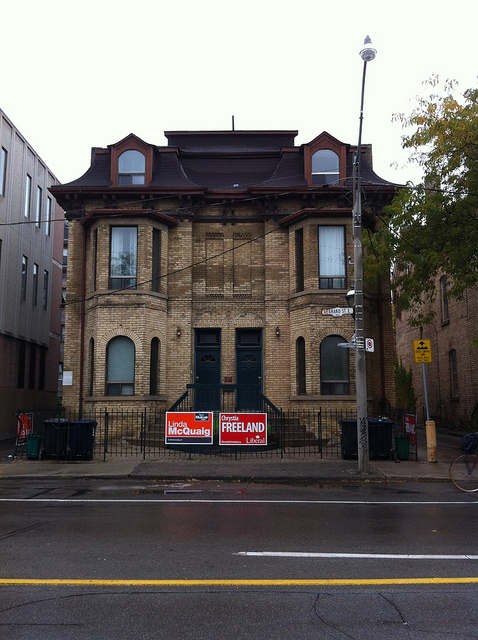For the first time in Canadian history, an election is being waged on this question: Which political candidate do you trust to reduce income inequality?
Welcome to the Toronto-Centre by-election, where voters go to the polls on November 25.
Two Toronto-Centre political candidates are stealing the show in this by-election for one simple reason: they’re the first Canadians to put income inequality front and centre during an election-time political campaign.
The candidates are: journalist Chrystia Freeland (Liberal), who wrote a book called The Plutocrats, and journalist Linda McQuaig (NDP), who recently wrote a book called The Problem With Billionaires.
Both McQuaig and Freeland are addressing income inequality at a time when the problem has been getting worse in Canada, as the richest among us enjoy a greater share of income gains from economic growth while the majority of Canadians fight for the remaining crumbs.
It’s an issue that seemed impossible to ignore during the Occupy movement in 2011 — which focused on the fate of the now iconic 99 per cent — but, remarkably, Canada’s political elite managed to let the issue fade once the Occupy tents came falling down.
Of all the ridings in Canada, it’s interesting that Toronto-Centre has turned into ground zero for the country’s first income inequality political debate.
The riding is the ultimate poster child for the gap between the rich and the poor.
The richest 20 per cent of income earners in Toronto-Centre keep company with the some of the most well-heeled people in Canada while the bottom 20 per cent of earners find themselves among the poorest in Canada.
Almost a quarter of Toronto-Centre households enjoy the lifestyle of the rich, registering before-tax incomes of more than $100,000. At the other extreme, a quarter of the riding’s residents live below the after-tax Low Income Measure (Ontario’s official measure of poverty), which is considerably higher than the provincial average of 14 per cent.
And for a by-election that talks frequently about Canada’s middle class, about 30 per cent of Toronto-Centre individuals earn between $40,000 and $100,000.
It is, quite simply, a riding of income extremes.
As the Toronto Star’s Susan Delacourt wrote about Toronto-Centre on the weekend: “It only takes about 30 minutes to walk one stretch of the income gap in Canada. Setting out southward from Rosedale, one of the country’s wealthiest neighbourhoods, a brisk, half-hour walk will take you to Regent Park, a low-income community in the heart of downtown Toronto.”
The rich in Toronto-Centre are also driving up the cost of living in that riding: it is one of the most expensive places in the country to buy a house. The average dwelling is valued at more than $675,000. In fact, about 40 per cent Toronto-Centre households spend more than 30 per cent of their total income on shelter costs.
What’s the opposite of a million-dollar mansion? In Toronto-Centre it’s subsidized housing, where a quarter of all renters in the riding live.
None of this is inevitable. As Pulitzer Prize-winning economist Joseph Stiglitz recently wrote: Income inequality is a political choice.
So what can we do about it?
We know from a growing body of international literature that societies which tolerate high levels of income inequality suffer higher levels of stress, greater levels of crime, worse health outcomes, and diminished trust — in each other and in their democratic institutions. So the question is not “should we act now to reduce income inequality” but simply a question of how quickly we move to stem the tide.
Our team of income inequality experts at the CCPA has pulled together a short primer for the Toronto-Centre by-election that doesn’t just talk about the problem of worsening income inequality in Canada — it offers preliminary solutions to close the gap.
Our team settled on four areas worthy of immediate action:
1. How to lift up Canadians who are at the very bottom of the income scale.
2. How to improve access to opportunities in the labour market through formal education.
3. How to make decent jobs a priority moving forward.
4. And how to make Canada’s tax system fairer than it currently is.
It is by no means an exhaustive list of solutions, of which there are many. It is the beginning of a national conversation the Toronto-Centre by-election candidates have hopefully helped to spark.
Click here for our short primer on income inequality, which includes questions for voters to ask of their candidates. It was made for the Toronto-Centre by-election, but since income inequality is a problem unfolding everywhere in Canada, it might prove a useful tool for others in future elections.
It’s one of many tools we’ve created at the CCPA to help spark a meaningful discussion about the problem of income inequality in Canada.
Here are a few other tools from the CCPA archives:
– This series talks about why income inequality matters in Canada.
– This blog looks at the advice from a range of CCPA experts on how to fix income inequality.
– This income inequality video is a good primer on income inequality in Canada.
– Hennessy’s Index looks at the richest 1 per cent and the middle class.
– This short video talks about Canada’s colour-coded labour market and how it’s contributing to income inequality.
Take these tools and join in a growing movement to change the conversation in Canada about income inequality — and about what’s possible.
Special thanks to CCPA Ontario economist Kaylie Tiessen for her contribution to this Toronto-Centre income inequality profile.
Trish Hennessy is director of the CCPA Ontario office. She is also a member of the CCPA’s national growing gap team. Learn more at www.growinggap.ca.
Photo: Neal Jennings/flickr



